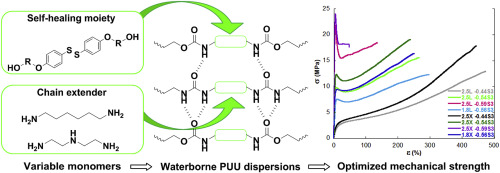Polymer ( IF 4.1 ) Pub Date : 2019-02-03 , DOI: 10.1016/j.polymer.2019.02.001 Sil Nevejans , Nicholas Ballard , Mercedes Fernández , Bernd Reck , José M. Asua

|
Implementation of the self-healing concept in coatings is challenging because they have to combine mechanical strength and chain mobility. This challenge is addressed in this work by studying the effect of the polymer microstructure on the mechanical properties and self-healing ability of waterborne poly(urethane-urea) coatings containing aromatic disulfide dynamic bonds. The structural modifications studied are the concentration and flexibility of the aromatic disulfide units and the effect of cross-linking. The effects and limits of these structural changes on the mechanical properties of the polymers and their healability were determined via a combination of DMA measurements, tensile tests, and rheological and scratch closure experiments. It was found that the flexibility of the disulfide unit was key to develop more efficient self-healing materials which offer the necessary molecular mobility for self-healing while simultaneously maintaining a level of mechanical strength that are essential for coating applications.
中文翻译:

柔性芳族二硫化物单体,用于高性能自修复的线性和交联聚(氨基甲酸酯-脲)涂料
在涂料中实施自我修复的概念具有挑战性,因为它们必须结合机械强度和链迁移性。通过研究聚合物微观结构对含有芳族二硫键的水性聚(氨基甲酸酯-脲)涂料的机械性能和自愈能力的影响,解决了这一难题。研究的结构修饰是芳族二硫键单元的浓度和柔韧性以及交联的影响。对聚合物及其healability的机械性能,这些结构变化的影响和限制进行了测定通过DMA测量,拉伸测试以及流变和划痕闭合实验的组合。已经发现,二硫化物单元的柔韧性对于开发更有效的自修复材料至关重要,该材料提供自修复所需的分子迁移率,同时保持对于涂料应用必不可少的机械强度水平。

































 京公网安备 11010802027423号
京公网安备 11010802027423号